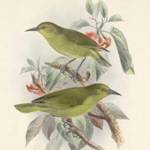Scarlet macaw
2019 CE • Costa Rica
"Depicted as the fiery god of light, Itzamna, in ancient Mayan legends, the scarlet macaw (Ara macao) is unmistakable. With a wingspan of nearly five feet and a squawk that can’t be ignored. . . As the 20th century dawned, the species was widespread across 85% of [Costa Rica]. By 1980 it was almost gone . . . Scarlet macaws in Costa Rica suffered two grim fates. First, they ate almost exclusively mountain almond (almendro amarillo). Deforestation, which peaked in the 1950s, had a devastating effect on the treed habitats these birds relied on both for food and nesting. The second problem, still persisting to some extent, was their popularity as pets. Since macaws mate for life, the loss of so many individual birds to the pet trade meant equal numbers would never breed again." Rigorous conservation efforts in recent years have focused on reintroduction and mating programs. Through these initiatives, the scarlet macaw has slowly adapted its diets to include other fruit and nut food sources, and the release of captive-raised macaws has been successful in expanding their current habitat range.
Tom Schultz, "Macaws Making a Costa Rican Comeback," Howler Magazine, December 30, 2019.
Image: Ben Lunsford, CC BY-SA 3.0 US, via Wikimedia Commons


Learn about Maya Lin’s fifth and final memorial: a multi-platform science based artwork that presents an ecological history of our world - past, present, and future.

Discover ecological histories and stories of former abundance, loss, and recovery on the map of memory.

Learn how we can reduce our emissions and protect and restore species and habitats – around the world.

See how art can help us rethink the problems we face, and give us hope that each one of us can make a difference.

Help make a global memorial something personal and close to home. Share your stories of the natural world.


